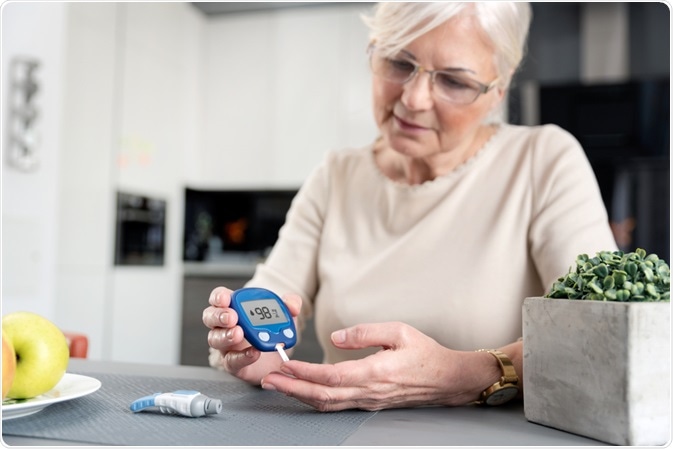Hypoglycemia is a condition where the blood level of glucose drops to below normal.

Image Credit: Proxima Studio / Shutterstock.com
Hypoglycemic events
Among most individuals with type 1 diabetes, the response of the hormone glucagon to low blood sugar is impaired. When these individuals use insulin to lower blood sugar levels, the absence of a normal glucagon response means the will prevent the blood sugar levels from being corrected, thus raising the risk of hypoglycemia.
The extent of hypoglycemia may be worsened by an overdose of anti-diabetes medication, vigorous exercise which depletes the body of sugar, excess alcohol intake, or missed meals and/or snacks. Most diabetic patients have become accustomed to recognizing the symptoms of low blood sugar which typically include tremors, sweating, palpitations, anxiety, and restlessness. Some diabetics, however, do not experience any symptoms of hypoglycemia at all, called hypoglycemia unawareness.
Dogs to detect hypoglycemia
Some experts suggest that animals such as dogs can help detect hypoglycemia in patients. Researchers say that owing to their acute sense of smell, dogs may be able to detect changes in the composition of their owner’s sweat that occur when they are becoming hypoglycemic. Another theory is that visual cues such as the owner looking disorientated or trembling may alert the dog.
Previous research has shown that dogs owned by individuals with diabetes exhibit behavioral changes in response to their owner’s blood sugar falling to below normal levels. Examples of these behaviors include nudging and licking their owner, especially around the mouth, and whining, barking, or howling.
How dogs can sniff out diabetes
In March 2008, a consumer magazine published by the American Diabetes Association called Diabetes Forecast featured an article about medical assistance dogs that were trained to recognize hypoglycemic episodes and alert their owner. The dogs were trained at a center in California which places such dogs with people who have type 1 diabetes. The dogs are then trained to sense when a dangerous fall in the individual's blood glucose levels is about to occur, allowing the owner to work together with the dog to prevent a hypoglycemic episode altogether.
It is not yet clear exactly how these dogs are able to sense the changes in their owners before an episode of hypoglycemia occurs; however, researchers believe that the dogs react to scents that are created when chemical changes occur in the body as a result of a glucose imbalance.
Currently, in the United States, only a few centers exist for training assistance dogs to help diabetics. The training is time-consuming and costly, meaning only a minimal number of dogs are available to be paired with an owner.
At one such center called “Dogs4Diabetes,” dogs are trained to become diabetic alert dogs and have been trained to sense and respond to identifiable changes in the blood chemistry that take place when their owner’s blood glucose level suddenly drops. This alerts the owner that they need to treat their hypoglycemia before they start to become symptomatic.
In order to train the dog, the animal is presented with various scents, one of which is the scent obtained from a diabetic person while they were experiencing a hypoglycemic episode. The dog is then taught to find and pick out the hypoglycemic scent. As the dog learns to recognize that scent, it is trained to respond to its owner in certain ways, such as sitting and staring at the person, jumping on them, or touching them with their nose.
Dogs such as labrador retrievers have more than 200 million sensors that can detect individual elements in parts per trillion. This compares with the parts per million smell capability that can be detected by current technology.
A rapid fall in blood glucose levels produces unique chemical elements that the dog can identify in a person’s breath or skin. Evidence suggests that these changes in a diabetic’s chemistry derived from sweat or breath occur 15 to 30 minutes before there is a measurable change in the blood sugar level that can be detected by a glucose monitor. The dog can therefore be trained to respond to the changes in sweat and breath and alert their owner before they experience any symptoms of hypoglycemia.
References
Further Reading
Last Updated: Nov 28, 2022